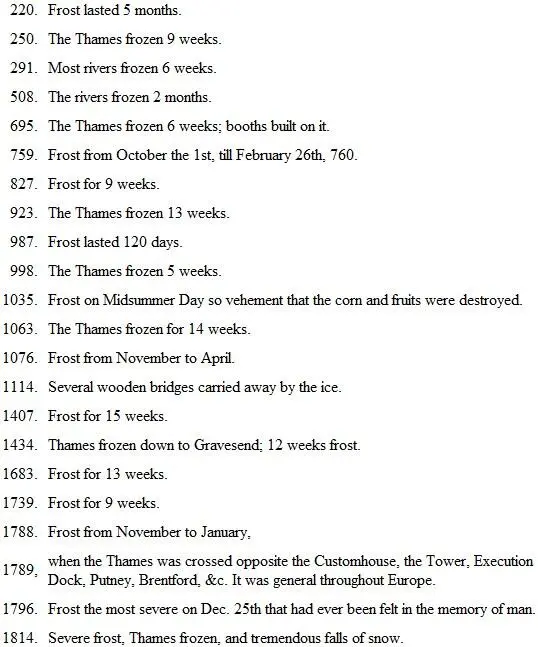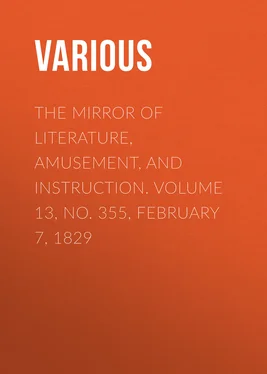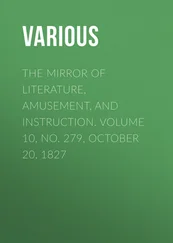Various - The Mirror of Literature, Amusement, and Instruction. Volume 13, No. 355, February 7, 1829
Здесь есть возможность читать онлайн «Various - The Mirror of Literature, Amusement, and Instruction. Volume 13, No. 355, February 7, 1829» — ознакомительный отрывок электронной книги совершенно бесплатно, а после прочтения отрывка купить полную версию. В некоторых случаях можно слушать аудио, скачать через торрент в формате fb2 и присутствует краткое содержание. Жанр: foreign_antique, periodic, Развлечения, foreign_edu, на английском языке. Описание произведения, (предисловие) а так же отзывы посетителей доступны на портале библиотеки ЛибКат.
- Название:The Mirror of Literature, Amusement, and Instruction. Volume 13, No. 355, February 7, 1829
- Автор:
- Жанр:
- Год:неизвестен
- ISBN:нет данных
- Рейтинг книги:5 / 5. Голосов: 1
-
Избранное:Добавить в избранное
- Отзывы:
-
Ваша оценка:
- 100
- 1
- 2
- 3
- 4
- 5
The Mirror of Literature, Amusement, and Instruction. Volume 13, No. 355, February 7, 1829: краткое содержание, описание и аннотация
Предлагаем к чтению аннотацию, описание, краткое содержание или предисловие (зависит от того, что написал сам автор книги «The Mirror of Literature, Amusement, and Instruction. Volume 13, No. 355, February 7, 1829»). Если вы не нашли необходимую информацию о книге — напишите в комментариях, мы постараемся отыскать её.
The Mirror of Literature, Amusement, and Instruction. Volume 13, No. 355, February 7, 1829 — читать онлайн ознакомительный отрывок
Ниже представлен текст книги, разбитый по страницам. Система сохранения места последней прочитанной страницы, позволяет с удобством читать онлайн бесплатно книгу «The Mirror of Literature, Amusement, and Instruction. Volume 13, No. 355, February 7, 1829», без необходимости каждый раз заново искать на чём Вы остановились. Поставьте закладку, и сможете в любой момент перейти на страницу, на которой закончили чтение.
Интервал:
Закладка:
From another account we learn that communication with the roof was not at first apprehended, but the roof of the choir being very dry wood, soon joined in the conflagration. It is impossible to describe the awful picture of the flames rising above this majestic building. The effect produced by the glare of light upon the stained glass of the windows exceeds description. On the falling of the roof, the house of prayer, which but the evening before had resounded with the voices of worshippers, and where all was order and harmony, now resembled a fiery furnace. The pillars, which once served to divide the choir from the two side aisles, now stood alone, the whole being an open space, with the roof burning on the ground, and nothing above but the blue canopy of heaven.
Mr. Britton, in his valuable work on York Cathedral, gives a minute description of that part of the Minster which has been destroyed; from which the following is extracted:—
"After passing through the screen, the visiter is introduced to the choir, which is grand in scale and rich in adornment. On each side is a series of 20 stalls, with 12 at the west end, beneath the organ. These are of oak, and are peculiarly rich in their canopies and carved decorations. Each seat, or stall, has its movable miserecordia, with projecting rests for the elbows, from which rise two detached slender columns, supporting an elaborate canopy. At the eastern end of the choir is the altar-table, raised above the regular floor by a series of 15 steps.
"On the north side of the altar, over the grated window that lights the crypt, is an ancient pew, or gallery, to which there is an ascent by a flight of narrow stairs, of solid blocks of oak. The exterior of this gallery is very neat, and it is certainly older than the Reformation.
"Behind the stalls of the choir are closets, some of which are used as vestries by the singing-men: modern staircases have been constructed, leading to the galleries erected above, and which disfigure the view into the aisles. These closets are fronted, next the aisles, by open screens of oak, some of which are of excellent carving, and more elaborate than others. In the centre of the choir stands a desk for the vicars-choral to chant the litany in; it is enclosed in a pew of carved wood."
The Minster was lighted with gas, to which the conflagration was at first attributed; but the fire appears to have originated in one of the vestries. When we remember the beauty of the carved work which has thus been destroyed, and the elaborate skill which had been bestowed on its execution, our sympathies are deeply awakened for its fate. Indeed, the most listless admirer of art, as well as the antiquarian devotee, has just cause to lament this accident; especially as the taste and labours of our times fall far short of the olden glories of architecture. When we think of the "unsubstantial pageant" of the recent "Festival," and associate its fleeting show with the desert remains of this venerable pile, our feelings deepen into melancholy, and the smoking fragments of art seem to breathe—
Tell thou the lamentable fall of me,
And send the hearers weeping to their beds.
HARD FROSTS IN ENGLAND
In the year

A French writer who visited England during the severe frost in the year 1688, says, (in a small volume which he published in Paris,) "that besides hackney-coaches, a large sledge, or sledges, were then exhibited on the frozen Thames, and that King Charles passed a whole night upon the ice."
The following extract is also an account of this frost by an eye-witness; which may be seen in the Beauties of England and Wales , vol. x. page 83: he says, "On the 20th of December, 1688, a very violent frost began, which lasted to the 6th of February, in so great extremity, that the pools were frozen 18 inches thick at least, and the Thames was so frozen that a great street from the Temple to Southwark was built with shops, and all manner of things sold. Hackney coaches plied there as in the streets. There were also bull-baiting, and a great many shows and tricks to be seen. This day the frost broke up. In the morning I saw a coach and six horses driven from Whitehall almost to the bridge (London Bridge) yet by three o'clock that day, February the 6th, next to Southwark the ice was gone, so as boats did row to and fro, and the next day all the frost was gone. On Candlemas Day I went to Croydon market, and led my horse over the ice to the Horseferry from Westminster to Lambeth; as I came back I led him from Lambeth upon the middle of the Thames to Whitefriars' stairs, and so led him up by them. And this day an ox was roasted whole, over against Whitehall. King Charles and the Queen ate part of it."
N.B. In 1740, a palace of ice was built by the Empress Anne of Russia, on the banks of the Neva, 52 feet long, which, when illuminated, had a surprising effect.
P. T. W.TURKISH PROPHECY
The following is extracted from a book of Prophecies, called Muhamedys, which is held in veneration by the Turks:—"The Turkish emperor shall conquer Rome, and make the pope patriarch of Jerusalem; and he shall, some time after, profess the Mahomedan faith. Christ shall then come, and show the Christians their error in not having accepted the Alcoran; and instruct them that the dove which came down from heaven was not the Holy Ghost, but was Mahomet, who shall be again upon earth thirty years, and confirm the Alcoran by new miracles. After that time the power of the Turks shall decline, till they retire into Desert Arabia, and then there shall be an end of the world. Their overthrow shall be accomplished by a people from the north, called caumico fer , (yellow-haired sons.) The ruin of Constantinople shall happen in sultan Mahomet's time; and then the Turks shall be reduced to so few in number, that sixty Turkish women shall have but one husband among them."
W. G. C.POPULAR SUPERSTITIONS, &c
We have formerly alluded to the well-known feats of the weird sisterhood on the broomstick; but it is affirmed that on these occasions the spirit left its earthly abode, the body being previously anointed with the ointment we have described. We cannot better illustrate this question (the possibility of which has been the subject-matter of many grave dissertations amongst the literati of those times) than by giving the substance of the following singular "Confession," which with many others equally interesting, was made in 1664, (the later days of the profession) before Robert Hunt, Esq., a "justice with fat capon lined," in the county of Somerset, and in the presence of "several grave and orthodox divines."
Elizabeth Styles, of Stoke Triston, in that county, was accused by "divers persons of credit," of the crimes of witchcraft and sorcery. She was afterwards found guilty by a jury at Taunton, but died before the sentence could be carried into effect. She confessed "that the devil, about ten years since, appeared to her in the shape of a handsome man, and after of a black dog; that he promised her money, and that she should live gallantly, and have the pleasure of the world for twelve years, if she would, with her blood, sign his paper, which was to give her soul to him, and observe his laws, and that he might suck her blood. This, after four solicitations, the examinant promised to do; upon which he pricked the fourth finger of her right hand, between the middle and upper joints, (where the sign at the examination remained), and with a drop or two of her blood, she signed the paper with an O. Upon this the devil gave her sixpence, and vanished with the paper. That since he hath appeared to her in the shape of a man, and did so on Wednesday sevennight past, but more usually he appears in the likeness of a dog, and cat, and a fly like a miller, in which last he usually sucks in the poll, about four of the clock in the morning, and did so January 27, and that it usually is pain to her to be so suckt." When she desired to do harm, she called Robin ; on his appearance she opened her wants, saying, O Satan, give me my purpose.
Читать дальшеИнтервал:
Закладка:
Похожие книги на «The Mirror of Literature, Amusement, and Instruction. Volume 13, No. 355, February 7, 1829»
Представляем Вашему вниманию похожие книги на «The Mirror of Literature, Amusement, and Instruction. Volume 13, No. 355, February 7, 1829» списком для выбора. Мы отобрали схожую по названию и смыслу литературу в надежде предоставить читателям больше вариантов отыскать новые, интересные, ещё непрочитанные произведения.
Обсуждение, отзывы о книге «The Mirror of Literature, Amusement, and Instruction. Volume 13, No. 355, February 7, 1829» и просто собственные мнения читателей. Оставьте ваши комментарии, напишите, что Вы думаете о произведении, его смысле или главных героях. Укажите что конкретно понравилось, а что нет, и почему Вы так считаете.












